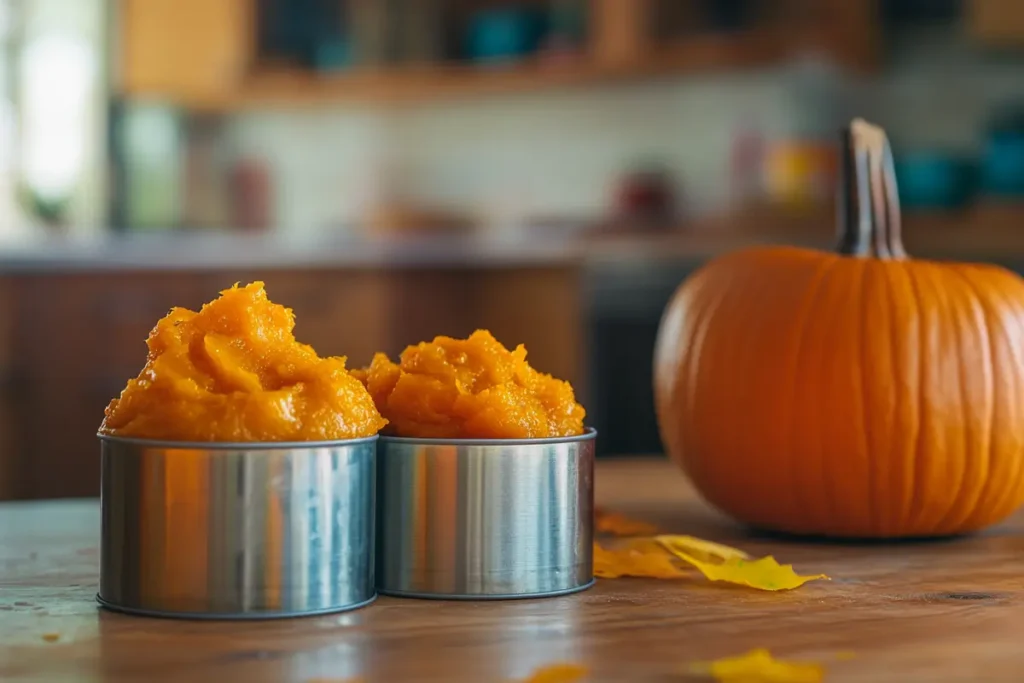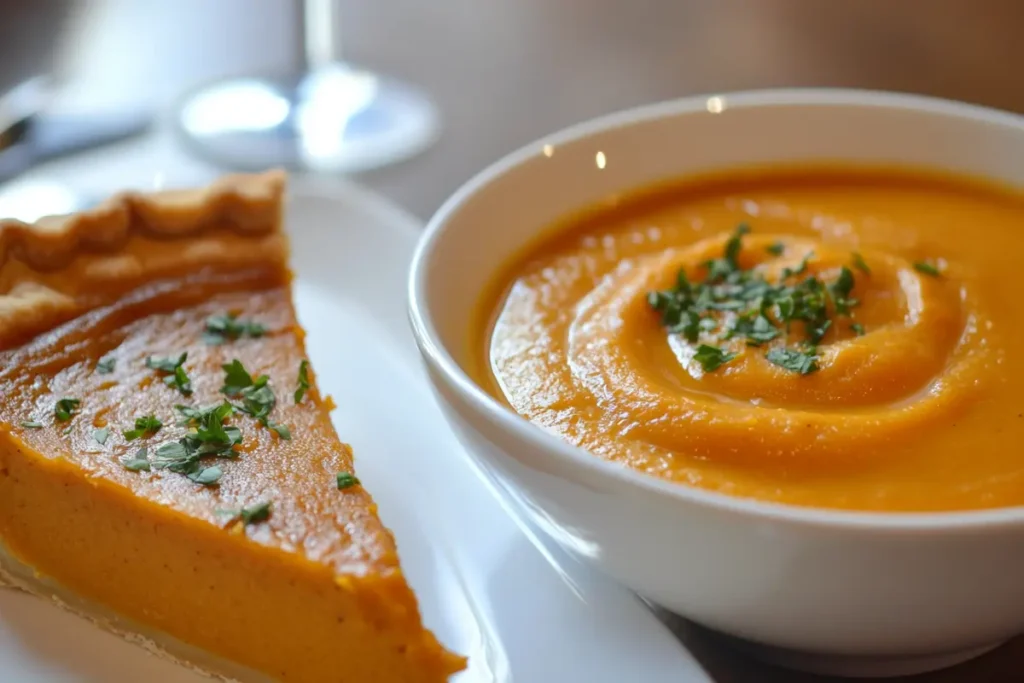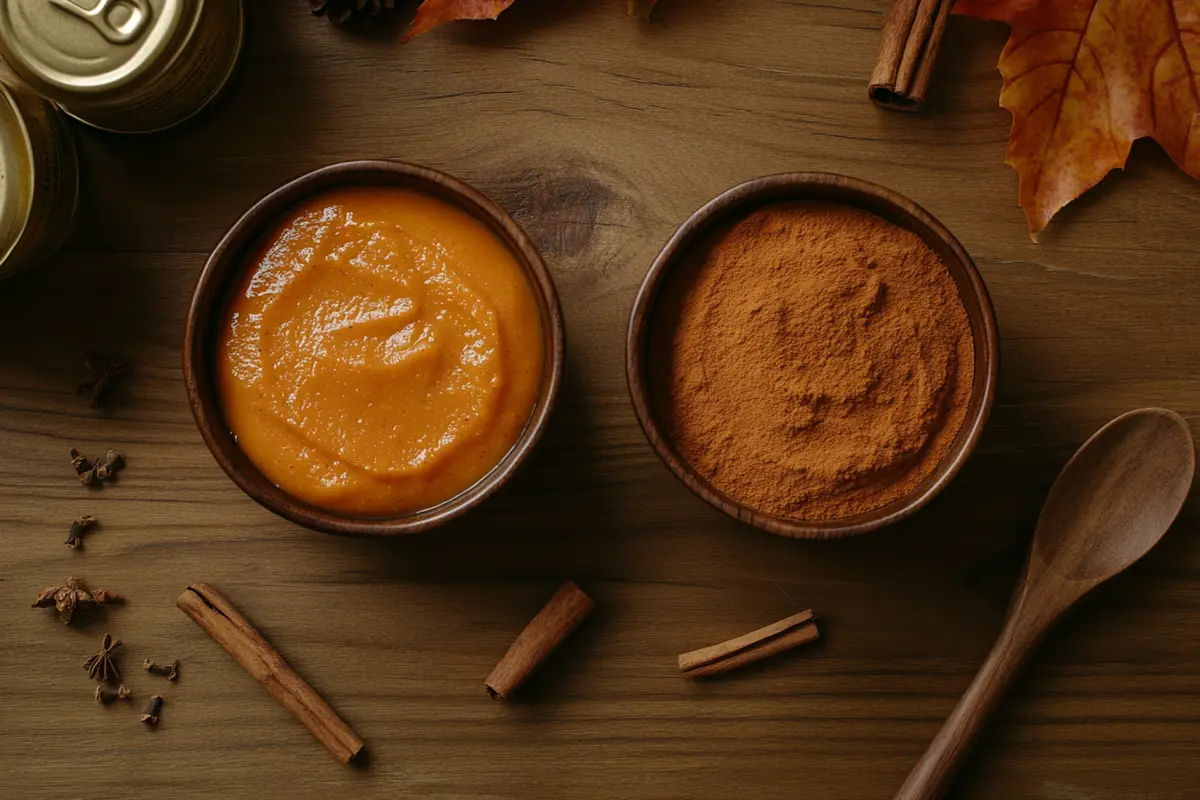Table of Contents
Is pumpkin mix and pumpkin puree the same? This is a common question among bakers and cooks alike, especially when tackling fall-themed recipes. Many recipes call specifically for pumpkin puree, while others might vaguely mention “pumpkin,” leading to confusion. Understanding the distinctions between these two products is essential for ensuring recipe success. Let’s delve into the key differences.
What is Pumpkin Puree?

Pumpkin puree is simply cooked pumpkin flesh that has been mashed or blended until smooth. It contains only one ingredient: pumpkin. Generally, a specific type of squash, such as Dickinson pumpkins, are used to create this puree because they provide a better texture and flavor compared to carving pumpkins. This product is naturally low in sugar and has a mild, earthy flavor, making it a versatile base for both sweet and savory recipes.
The Production of Pumpkin Puree
The process of creating pumpkin puree involves cooking the pumpkin to soften its flesh. This can be achieved by roasting, steaming, or boiling. Once softened, the flesh is scooped out and pureed until it reaches a smooth consistency. It’s then packaged into cans or jars for convenient use. It’s important to note no other ingredients are added during this process, ensuring a pure and natural product.
The Taste and Texture of Puree
The taste of pumpkin puree is often described as subtly sweet and earthy, lacking strong spices or added sugars. Its texture is smooth and thick, but not overly so. It’s the perfect consistency to blend into batters, sauces, or other mixtures. Image Placeholder: alt text “Pumpkin Puree texture” shows a close up of pumpkin puree in a bowl with a spoon
What is Pumpkin Mix?
Pumpkin mix, or pumpkin pie filling, is a completely different product from pumpkin puree. It’s a pre-made mixture designed to be poured straight into pie crusts. It typically contains pumpkin puree as its base, but also includes added sweeteners, spices, and often thickeners. This pre-mixed nature makes it very convenient for making pies. However, this convenience means it’s unsuitable for recipes not specifically designed for pumpkin pie filling.
Examining the Ingredients
A typical pumpkin pie mix contains pumpkin puree, sugar, spices like cinnamon, nutmeg, and ginger, and sometimes thickeners such as modified cornstarch. These added ingredients contribute to a sweeter and spicier flavor profile that differs vastly from plain puree. It’s important to always read labels carefully since different brands may vary on the amount and type of spices and sweeteners. Image Placeholder: a close up image of ingredients list for pumpkin mix.
The Taste and Texture of Mix
The taste of pumpkin mix is much sweeter and more heavily spiced than plain pumpkin puree. The texture tends to be more viscous due to the added thickeners. Its consistency is designed to hold its shape when baked in a pie shell. This makes it easy for creating pumpkin pies but challenging to use in other recipes that require the plain taste of pumpkin puree.
Key Differences Between Pumpkin Mix and Pumpkin Puree
The most significant difference between pumpkin mix and pumpkin puree lies in their ingredients. Pumpkin puree is 100% pumpkin, with no other additives. Conversely, pumpkin mix contains pumpkin puree plus sugar, spices, and often thickeners. The taste, texture, and intended use of these two products are also significantly different. Furthermore, their nutritional profiles vary, with mix having a much higher sugar content.

Intended Usage
Pumpkin puree is a versatile ingredient that can be used in many sweet and savory recipes. It’s ideal for things like pumpkin bread, muffins, soups, and even smoothies. Pumpkin mix, on the other hand, is primarily intended for making pumpkin pies. Its pre-mixed nature and specific flavor profile don’t make it suitable for these other recipes. It’s essential to choose the correct type for each dish.
Nutritional Variation
Another key difference is their nutritional value. Puree is a good source of vitamins, minerals, and fiber, with low sugar content. Pumpkin mix, due to its added sugar, contains significantly more carbohydrates and calories. Individuals who are watching their sugar intake may want to avoid pumpkin pie mix, opting for pure pumpkin instead. Image Placeholder: A side-by-side comparison of nutritional facts labels for pumpkin puree and pumpkin mix.
Can They be Substituted?
The big question: can you substitute pumpkin mix for puree, or vice versa? Generally, it’s not recommended to directly substitute one for the other. The difference in ingredients will likely cause issues with flavor and consistency. However, if you are careful and understand the differences, there may be a workaround.
Substituting Puree for Mix
If a recipe calls for pumpkin mix, you can use pumpkin puree but you will need to add your own sweeteners and spices. It might also require some adjustment to the liquid content to match the consistency of the mix. Start with a small amount of sweetener and spices and adjust to taste. This will require more work but can still produce good results.
Substituting Mix for Puree
Substituting pumpkin mix for puree is more difficult. This is because you cannot easily remove the sugar and spices already added. Using mix in a recipe that calls for puree will likely result in a dish that is too sweet, over-spiced, and potentially the wrong texture. The result might be completely inedible. It is best to avoid this substitution, if possible.
Essential Considerations When Choosing
When purchasing pumpkin products, you must read labels carefully to differentiate between pumpkin puree and pumpkin mix. Look for the specific words “puree” or “pie filling” on the label, as the packaging is often similar, adding to the confusion. If the ingredients list includes anything besides pumpkin, it is not puree. Consider what kind of dish you are creating.
Recipe Requirements
The main determining factor in choosing between puree and mix is the recipe. If a recipe specifically calls for pumpkin puree, using mix will likely result in an undesirable outcome. Similarly, using puree in a recipe designed for mix will result in a bland pie. Pay close attention to the ingredients list of each recipe you follow and use the corresponding pumpkin product.
Flavor Profiles
Consider the desired flavor of your final dish. If you want a naturally sweet, mild pumpkin flavor, choose puree. If you want a pre-spiced, sweeter profile, pumpkin mix might be a better choice. Understanding these flavor nuances will ensure your culinary success. Each has its place in the kitchen.
Amazing Uses for Pumpkin Puree
The versatility of pumpkin puree extends beyond just pumpkin pies. It can be used in a multitude of ways to add flavor and nutrients to meals. It’s an excellent addition to both sweet and savory dishes. This makes pumpkin puree an amazing ingredient to keep on hand during the fall and winter seasons. Image Placeholder: Collage showing various ways to use pumpkin puree, including soups, breads, and smoothies.

Baking Applications
Pumpkin puree is a great addition to baked goods. It adds moisture and flavor to breads, muffins, cakes, and cookies. It can also be used to create healthier baked goods, replacing some of the oil or butter in the recipe. This makes pumpkin puree a versatile and nutritious ingredient. It’s also often used in healthier pancake or waffle recipes.
Savory Applications
The use of pumpkin puree is not limited to baking. It can be added to soups, stews, and chili, adding depth of flavor and a creamy texture. It can also be used in sauces for pasta or as a base for dips. Additionally, it’s a common ingredient in Indian and Asian curries. Its versatility in savory dishes is often overlooked.
Smoothies and Beverages
Pumpkin puree can be blended into smoothies, providing a boost of nutrients and fiber. You can make a delicious pumpkin spice latte at home with a little bit of puree. The mild flavor combines well with other ingredients in smoothies. It can even be used in protein shakes to add extra vitamins.
The Ultimate Choice
Choosing between pumpkin puree and pumpkin mix depends on your recipe and needs. If your recipe requires only pumpkin flavor, use puree. If you are making a pie, use the mix. Always check labels carefully and do not assume they are interchangeable. Understanding the differences can make your recipes that much better. Consider your dietary needs as well.
Recipe Success
Paying close attention to detail is key to a successful recipe outcome. When baking, using the correct form of pumpkin makes all the difference in flavor and texture. Using the wrong type will alter the results. Understanding the basic differences is a fundamental first step to successful fall baking.
Informed Decisions
By understanding the differences between pumpkin puree and pumpkin mix, you can be better equipped to make informed choices. You’ll be less likely to waste ingredients or have an unsatisfactory result. Knowing the differences will elevate your baking and cooking experiences this fall and beyond.
Recipe-Specific Details:
To help further illustrate the difference, let’s consider a simple recipe comparison: Pumpkin Bread using Pumpkin Puree and Pumpkin Pie. This will highlight the distinct use cases for each ingredient.
Recipe 1: Pumpkin Bread with Pumpkin Puree
This recipe showcases the versatility of pumpkin puree in a classic baked good. It emphasizes the need for adding your own sweeteners and spices for flavor.
Ingredients:
- Pumpkin Puree: 1 15-ounce can (about 1 ¾ cups) of 100% pure pumpkin puree. Ensure it has only one ingredient: pumpkin. You can also make your own by roasting, steaming, or boiling pumpkin, then pureeing it until smooth. A Dickinson pumpkin will give you the best flavor and texture for your puree.
- All-Purpose Flour: 3 cups. For a gluten-free option, use a 1:1 gluten-free flour blend, such as Bob’s Red Mill. Note that you might need to add a bit more liquid if you use a gluten-free blend, as it can be drier.
- Granulated Sugar: 1 ½ cups. You can reduce this to 1 cup if you prefer a less sweet bread or replace half with brown sugar for a more molasses-like flavor. Maple syrup or honey can be used as a substitute, but start with 3/4 cup.
- Vegetable Oil: ¾ cup. Canola or sunflower oil work well due to their neutral flavor. Melted coconut oil or unsalted butter can also be used for different flavor profiles.
- Eggs: 2 large. Look for large, fresh eggs. Ensure they are not cracked. If vegan, substitute 2 flax eggs (2 tablespoons of flaxseed meal mixed with 6 tablespoons of water, let sit for 5 minutes).
- Water: ½ cup. Use purified water to ensure no unwanted flavors affect the outcome.
- Baking Soda: 1 teaspoon. Make sure your baking soda is not expired.
- Baking Powder: ½ teaspoon. Check the freshness of baking powder, as it loses efficacy over time.
- Salt: 1 teaspoon. Table salt is standard, but you can use sea salt or kosher salt if you prefer.
- Cinnamon: 1 teaspoon. Freshly ground cinnamon will provide a more vibrant flavor than store-bought pre-ground spices.
- Nutmeg: ½ teaspoon. Freshly grated nutmeg offers superior flavor.
- Ginger: ½ teaspoon. Ground ginger works well, but you can also use fresh ginger, finely grated, if desired (about 1 teaspoon).
- Optional Add-ins: ½ cup of chocolate chips, chopped nuts, or dried cranberries.
Preparation Instructions:
- Preheat the Oven: Preheat your oven to 350°F (175°C). Grease and flour a standard loaf pan (9×5 inch).
- Combine Wet Ingredients: In a large bowl, whisk together the pumpkin puree, oil, sugar, eggs, and water until well combined.
- Mix Dry Ingredients: In a separate bowl, whisk together the flour, baking soda, baking powder, salt, cinnamon, nutmeg, and ginger.
- Combine Wet and Dry: Gradually add the dry ingredients to the wet ingredients, mixing until just combined. Do not overmix.
- Add Optional Mix-Ins: Stir in any optional add-ins (chocolate chips, nuts, etc.).
- Pour Into Pan: Pour the batter into the prepared loaf pan.
- Bake: Bake for 50-60 minutes, or until a toothpick inserted into the center comes out clean.
- Cool: Let the bread cool in the pan for 10 minutes before transferring to a wire rack to cool completely.
Cooking Tips:
- Avoid Overmixing: Overmixing the batter can result in a tough bread. Mix only until the ingredients are just combined.
- Oven Temperature: Use an oven thermometer to ensure your oven’s temperature is accurate.
- Toothpick Test: The toothpick test is crucial. Ensure it comes out clean, or the bread may be underbaked.
- Cooling Time: Do not cut into the bread until it’s completely cooled; it helps prevent it from crumbling.
- Altitude Adjustments: If baking at high altitudes, reduce the baking powder slightly and increase the liquid a bit.
Recipe 2: Classic Pumpkin Pie with Pumpkin Mix
This recipe will highlight that pumpkin mix comes ready-made to pour into a pie crust and bake. It does not require additional sweeteners or spices, which are already present in the mix.
Ingredients:
- Pumpkin Pie Filling (Pumpkin Mix): 1 15-ounce can of pumpkin pie filling. Ensure it is specifically labeled as “pie filling” or “pumpkin mix.”
- Eggs: 2 large. Make sure your eggs are fresh and not cracked.
- Evaporated Milk: 1 12-ounce can. Full-fat evaporated milk creates the creamiest result. You can use half-and-half as a substitute, but the texture may be slightly less rich.
- Pre-made Pie Crust: 1 9-inch pie crust, either store-bought or homemade. Choose a good quality crust that won’t become soggy.
Preparation Instructions:
- Preheat Oven: Preheat your oven to 425°F (220°C).
- Whisk Ingredients: In a large bowl, whisk together the pumpkin mix, eggs, and evaporated milk until smooth.
- Pour into Crust: Pour the mixture into the prepared pie crust.
- Bake: Bake for 15 minutes at 425°F (220°C), then reduce the oven temperature to 350°F (175°C) and bake for another 40-50 minutes, or until the center is set (it will wobble slightly).
- Cool: Let the pie cool completely on a wire rack before serving.
Cooking Tips:
- Prevent Cracking: To prevent the edges of the pie crust from burning and the filling from cracking, you can use a pie crust shield or cover the edges with foil for the first half of baking.
- Center Check: The center of the pie should wobble slightly when done. It will continue to set as it cools.
- Cooling Time: Do not cut into the pie until it’s completely cooled; the filling will not be completely set and will be harder to serve.
- Room Temperature: Ensure your eggs are at room temperature to help the ingredients combine more smoothly.
- Evaporated Milk: Using full fat evaporated milk instead of low fat creates a richer, creamier texture.
FAQ
What is the difference between pumpkin mix and pumpkin puree?
Pumpkin puree is simply mashed cooked pumpkin with no other added ingredients. Pumpkin mix, or pie filling, contains pumpkin puree along with sugar, spices, and thickeners. Puree is naturally mild and unsweetened, while mix is sweet and spiced. They have different tastes, consistencies, and uses in recipes.
Can I use pumpkin pie filling to make pumpkin bread?
While you can technically use pumpkin pie filling to make pumpkin bread, it’s generally not recommended. The added sugar and spices in pie filling will make your bread overly sweet and may result in an altered texture. It’s best to use pumpkin puree if your recipe calls for it and add your own sweeteners and spices.
What is equivalent to pumpkin puree?
There isn’t a perfect substitute for pumpkin puree, but other squashes like butternut squash or acorn squash can be used in some instances. They offer a similar texture and mild flavor. However, the taste profile will be slightly different. These squashes are often less sweet than a pumpkin puree. They should be prepared by roasting, steaming, or boiling and then pureed until smooth.
Can you use regular pumpkin instead of pumpkin puree?
Yes, you can use “regular” pumpkins (such as Dickinson pumpkins) instead of canned pumpkin puree if you take the time to properly prepare it. You will need to cook and puree the fresh pumpkin to achieve the smooth consistency needed. It’s important to note that the moisture content might vary, so adjust the recipe as needed. However, this method is not as convenient as using canned puree.

